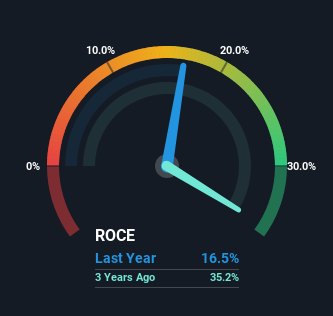- China
- /
- Consumer Durables
- /
- SZSE:001323
Investors Could Be Concerned With De Rucci Healthy Sleep's (SZSE:001323) Returns On Capital

What are the early trends we should look for to identify a stock that could multiply in value over the long term? One common approach is to try and find a company with returns on capital employed (ROCE) that are increasing, in conjunction with a growing amount of capital employed. This shows us that it's a compounding machine, able to continually reinvest its earnings back into the business and generate higher returns. However, after briefly looking over the numbers, we don't think De Rucci Healthy Sleep (SZSE:001323) has the makings of a multi-bagger going forward, but let's have a look at why that may be.
What Is Return On Capital Employed (ROCE)?
For those who don't know, ROCE is a measure of a company's yearly pre-tax profit (its return), relative to the capital employed in the business. Analysts use this formula to calculate it for De Rucci Healthy Sleep:
Return on Capital Employed = Earnings Before Interest and Tax (EBIT) ÷ (Total Assets - Current Liabilities)
0.17 = CN¥760m ÷ (CN¥7.1b - CN¥2.5b) (Based on the trailing twelve months to September 2023).
Thus, De Rucci Healthy Sleep has an ROCE of 17%. On its own, that's a standard return, however it's much better than the 8.2% generated by the Consumer Durables industry.
Check out our latest analysis for De Rucci Healthy Sleep

Above you can see how the current ROCE for De Rucci Healthy Sleep compares to its prior returns on capital, but there's only so much you can tell from the past. If you'd like to see what analysts are forecasting going forward, you should check out our free analyst report for De Rucci Healthy Sleep .
So How Is De Rucci Healthy Sleep's ROCE Trending?
When we looked at the ROCE trend at De Rucci Healthy Sleep, we didn't gain much confidence. Over the last four years, returns on capital have decreased to 17% from 39% four years ago. Given the business is employing more capital while revenue has slipped, this is a bit concerning. If this were to continue, you might be looking at a company that is trying to reinvest for growth but is actually losing market share since sales haven't increased.
On a related note, De Rucci Healthy Sleep has decreased its current liabilities to 36% of total assets. That could partly explain why the ROCE has dropped. Effectively this means their suppliers or short-term creditors are funding less of the business, which reduces some elements of risk. Some would claim this reduces the business' efficiency at generating ROCE since it is now funding more of the operations with its own money.
Our Take On De Rucci Healthy Sleep's ROCE
From the above analysis, we find it rather worrisome that returns on capital and sales for De Rucci Healthy Sleep have fallen, meanwhile the business is employing more capital than it was four years ago. Long term shareholders who've owned the stock over the last year have experienced a 30% depreciation in their investment, so it appears the market might not like these trends either. Unless there is a shift to a more positive trajectory in these metrics, we would look elsewhere.
While De Rucci Healthy Sleep doesn't shine too bright in this respect, it's still worth seeing if the company is trading at attractive prices. You can find that out with our FREE intrinsic value estimation for 001323 on our platform.
While De Rucci Healthy Sleep isn't earning the highest return, check out this free list of companies that are earning high returns on equity with solid balance sheets.
New: Manage All Your Stock Portfolios in One Place
We've created the ultimate portfolio companion for stock investors, and it's free.
• Connect an unlimited number of Portfolios and see your total in one currency
• Be alerted to new Warning Signs or Risks via email or mobile
• Track the Fair Value of your stocks
Have feedback on this article? Concerned about the content? Get in touch with us directly. Alternatively, email editorial-team (at) simplywallst.com.
This article by Simply Wall St is general in nature. We provide commentary based on historical data and analyst forecasts only using an unbiased methodology and our articles are not intended to be financial advice. It does not constitute a recommendation to buy or sell any stock, and does not take account of your objectives, or your financial situation. We aim to bring you long-term focused analysis driven by fundamental data. Note that our analysis may not factor in the latest price-sensitive company announcements or qualitative material. Simply Wall St has no position in any stocks mentioned.
About SZSE:001323
De Rucci Healthy Sleep
Engages in the research and development, production, and sale of healthy sleep systems in China and internationally.
Excellent balance sheet and good value.


